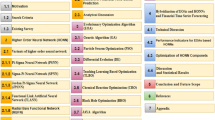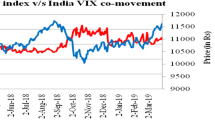Abstract
Predicting stock market time series is a challenging problem due to their random nature, non-stationarity and noise. In this study, we introduce an enhanced evolutionary artificial neural network (EANN) model to meet this challenge. Here, fractal analyses based on Hurst exponent calculations are used to characterize the time series and to identify appropriate input windows for the EANN. We investigate the efficacy of the model using closing price time series for a suite of stocks listed on the SPI index on the Australian Stock Exchange. The results show that Hurst exponent configured models out-perform basic EANN models in terms of average trading profit found using a simple trading strategy.
Preview
Unable to display preview. Download preview PDF.
Similar content being viewed by others
References
Abraham, A., Philip, N.S., Saratchandran, P.: Modeling Chaotic Behavior of Stock Indices Using Intelligent Paradigms. International Journal of Neural, Parallel & Scientific Computations 11(1-2), 143–160 (2003)
Cajuerio, D.O., Tabak, B.M.: The Hurst exponent over time: testing the assertion that emerging markets are becoming more efficient. Physica A 336, 521 (2004)
Chen, A.S., Leung, M.T., Daouk, H.: Application of Neural Networks to an Emerging Financial Market: Forecasting and Trading the Taiwan Stock Index. Computers and Operations Research 30, 901–923 (2003)
Kim, D., et al.: Forecasting time series with genetic fuzzy predictor ensembles. IEEE Trans. Fuzzy Syst. 5, 523–535 (1997)
Dorffner, G.: Neural Networks for Time Series Processing. Neural Network World 6(4), 447–468 (1996)
Hurst, H.E.: Long-term storage of reservoirs: an experimental study. Transactions of the American society of civil engineers 116, 770–799 (1951)
Kimoto, T., Asakawa, K., Yoda, M., Takeoka, M.: Stock market prediction system with modular neural network. In: Proceedings of the International Joint Conference on Neural Networks (1990)
Kong, Y.K., Moon, B.R.: Evolutionary ensemble for Stock Prediction. In: Deb, K., et al. (eds.) GECCO 2004. LNCS, vol. 3103, pp. 1102–1113. Springer, Heidelberg (2004)
Peters, E.E.: Fractal market analysis: applying chaos theory to investment and economics. Wiley, New York (1994)
Qian, B., Rasheed, K.: Hurst Exponent and Financial Market Predictability. FEA - Financial Engineering and Applications, 437–443 (2004)
Resta, M.: R/S Approach to Trends Breaks Detection. In: Khosla, R., Howlett, R.J., Jain, L.C. (eds.) KES 2005. LNCS (LNAI), vol. 3681, Springer, Heidelberg (2005)
Ruan, J., Pang, S.L., Luo, W.Q.: The MultiFractal Structure Analysis in the China Stock Market. In: Proceedings of 2005 International Conference on Machine Learning and Cybernetics, vol. 5, pp. 18–21 (2005)
Tekbas, O.H.: Modelling of chaotic time series using a variable length windowing approach. Chaos, Solitons & Fractals 29(2), 277–281 (2006)
Tino, P., Schittenkopf, C., Dorffner, G.: Financial volatility trading using recurrent neural networks. IEEE-Neural Networks 12, 865–874 (2001)
Yakuwa, F., Dote, Y., Yoneyama, M., Uzurabashi, S.: Novel Time Series Analysis & Prediction of Stock Trading using Fractal Theory and Time Delayed Neural Network. In: IEEE International Conference on Systems, Man and Cybernetics, October 5-8, vol. 1, pp. 134–141 (2003)
Yao, J.T., Tan, C.L., Poh, H.L.: Neural Networks for Technical Analysis: A Study on KLCI. International Journal of Theoretical and Applied Finance 2(2), 221–241 (1999)
Yao, X.: Evolving artificial neural networks. Proceedings of the IEEE Neural Networks 8(9), 1423–1447 (1999)
Yao, X., Lim, Y.: New Evolutionary System for Evolving Artificial Neural Networks. IEEE Transactions on Neural Networks 8(3), 694–713 (1997)
Author information
Authors and Affiliations
Editor information
Editors and Affiliations
Rights and permissions
Copyright information
© 2006 Springer-Verlag Berlin Heidelberg
About this paper
Cite this paper
Selvaratnam, S., Kirley, M. (2006). Predicting Stock Market Time Series Using Evolutionary Artificial Neural Networks with Hurst Exponent Input Windows. In: Sattar, A., Kang, Bh. (eds) AI 2006: Advances in Artificial Intelligence. AI 2006. Lecture Notes in Computer Science(), vol 4304. Springer, Berlin, Heidelberg. https://doi.org/10.1007/11941439_66
Download citation
DOI: https://doi.org/10.1007/11941439_66
Publisher Name: Springer, Berlin, Heidelberg
Print ISBN: 978-3-540-49787-5
Online ISBN: 978-3-540-49788-2
eBook Packages: Computer ScienceComputer Science (R0)




